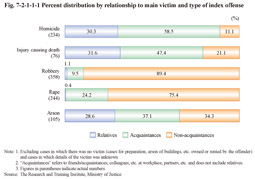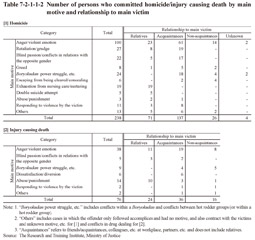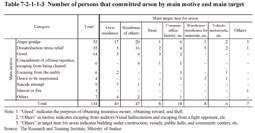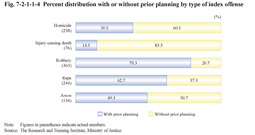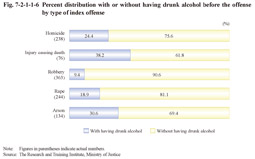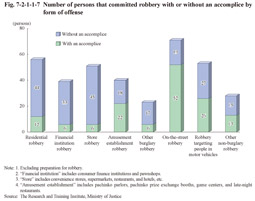1 Details of offenses
Fig. 7-2-1-1-1 shows the percent distribution by relationship to the main victims (refers to the victims who suffered the greatest damage from the offense; for arson the owners or actual users of the damaged items were regarded as being the victim). The proportion of offenses committed against relatives or other acquaintances was high for homicide and injury causing death and that against non-acquaintances high for robbery and rape. In recent years the proportion of homicide or injury causing death committed against relatives has been rising, while that of rape committed against non-acquaintances has been declining (See Fig. 7-1-1-4).
Fig. 7-2-1-1-1 Percent distribution by relationship to main victim and type of index offense
Table 7-2-1-1-2 shows the main motives for committing homicide or injury causing death by the relationship to the main victim. For homicide anger/violent emotion was the largest in number, regardless of the relationship to the main victim, but exhaustion from nursing care/nurturing was also high with homicide committed against relative. Anger/violent emotion was also the largest in number for injury causing death, but abuse/punishment was also high for that committed against relatives.
Table 7-2-1-1-2 Number of persons who committed homicide/injury causing death by main motive and relationship to main victim
Table 7-2-1-1-3 shows the number of persons that committed arson by main motive and main target (target the offenders had the strongest intention to harm). By main target the residences of others were the largest in number, followed by their own residences. By main motive anger/grudge was the largest in number, followed by dissatisfaction/stress relief (so-called pleasure offenses). For offenses committed for pleasure the main targets vary, which is considered to be due to the fact that no particular reason exists for selecting the target in those cases.
Table 7-2-1-1-3 Number of persons that committed arson by main motive and main target
Fig. 7-2-1-1-4 shows the percent distribution with or without prior planning by type of index offense and Fig. 7-2-1-1-5 the percent distribution involving use or no use of a weapon by type of index offense, but excluding arson. Approximately 40% of homicide cases were committed with prior planning. For injury causing death the proportion of those with prior planning and with use of weapons was low, indicating that many unexpectedly committed the offense. In contrast to that, the proportion of those with prior planning and with use of weapons was high for robbery, thus indicating that many had committed the offense in a planned manner by preparing a weapon. However, approximately 20% of them had committed the offense without any prior planning. The proportion of those with prior planning was also high for rape, but quite a few had also committed the offense without any prior planning.
Fig. 7-2-1-1-4 Percent distribution with or without prior planning by type of index offense
Fig. 7-2-1-1-5 Percent distribution of use or no use of a weapon by type of index offense
Fig. 7-2-1-1-6 shows the percent distribution with or without drinking alcohol at the time of the offense by type of index offense. It revealed that an inverse correlation with prior planning existed. The proportion of those that had drunk alcohol before the offense was high for injury causing death, thus indicating that drinking alcohol was a major factor in the offense, with the same holding true for arson.
Fig. 7-2-1-1-6 Percent distribution with or without having drunk alcohol before the offense by type of index offense
Fig. 7-2-1-1-7 shows the number of offenders for robbery with or without an accomplice by form of offense. The proportion of those without an accomplice was high for burglary robbery but excluding amusement establishment robbery, while that with accomplices was remarkably high for on-the-street robbery.
Fig. 7-2-1-1-7 Number of persons that committed robbery with or without an accomplice by form of offense
